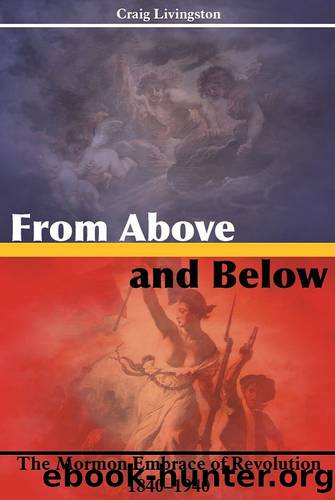From Above and Below: The Mormon Embrace of Revolution, 1840-1940 by Craig Livingston

Author:Craig Livingston [Livingston, Craig]
Language: eng
Format: epub
Tags: History, Military, Revolutions & Wars of Independence, Religion, Christianity, Church of Jesus Christ of Latter-Day Saints (Mormon)
ISBN: 9781589586215
Google: Vg7znAEACAAJ
Publisher: Greg Kofford Books
Published: 2013-08-15T04:00:00+00:00
CHAPTER 9
The Bolshevik Revolution of 1917
Reordering the World
American entry into World War I in April 1917 ensured that President Woodrow Wilson would play a role in the peace settlement. To promote his Fourteen Points for world peace, Wilson needed an American army in France under all-American command. A military victory won by his soldiers and generals would show that America, too, had paid the price in blood. Without this example, says historian Ernest May, Wilson would have been forced to âsacrifice Americaâs prestige and moral influenceâ in the peace talks. With a show of the flag in the trenches, however, Wilson would be able to get hard-bitten Allied leaders to go along with the last and most cherished of his Fourteen Points: a League of Nations.1 The League would bind nations to a common standard of conduct. Through joint action, member states could contain nations threatening global stability. European heads-of-state wanted much the same thing, but not before punishing Germany. The appeal of Wilsonâs message in the United States and Europe reached messianic proportions. Thomas J. Knock suggests that the effusive reception Wilson received when he arrived for the Paris peace talks âtranscended mere pageantry. Indeed, [it was] an articulate expression of mass political opinionâand one, significantly, set in motion by the liberal, labor, and socialist movements within the Allied countries.â2
Mormon observers saw World War I, the 1917 Bolshevik Revolution in Russia, and the pending League of Nations fight as events representing a righteous cause. Amidst the ruins of European military power, men and women inspired by transcendent ideas might design a new world order founded on self-determination and international cooperation. Richard Gamble writes that American ministers went from pacifists to crusading internationalists: missionaries for the creeds of democracy and collective security.3 For example, Harry F. Ward, author of the Methodist Social Creed, had once chaired the antiwar American Union against Militarism, believing capitalists and imperialists had caused the war. As the war progressed, however, Ward came to accept it as necessary for the reconstruction of the world order. As the Paris Peace talks got underway, he worried that Allied ministers would sabotage solutions to problems that stood in the way of global solidarity and peace. Equating communism with Christianity and capitalism with anti-Christian selfishness, Ward warned that if âdemocracy does not make a way for economic change without class war, Western civilization is headed for complete and overwhelming disaster.â4 Not all Protestant churchmen agreed; in 1919 the Federal Council of Churches decried Bolshevism as a new absolutism.5 Several Mormon observers, however, came close to Wardâs assessment.
For Mormon observers, intervention in World War I and membership in the League of Nations were essential to human progress. Apostle Charles A. Callis invoked the memory of Joseph Smith to justify the terrible drama on the âbloody battlefields in France:â
We hold that Joseph Smith was one of the foremost exponents and champions of human liberty. Our soldier boys are fighting for the cause of human liberty. They are battling for a cause which God looks upon and approves.
Download
This site does not store any files on its server. We only index and link to content provided by other sites. Please contact the content providers to delete copyright contents if any and email us, we'll remove relevant links or contents immediately.
| Civilization & Culture | Expeditions & Discoveries |
| Jewish | Maritime History & Piracy |
| Religious | Slavery & Emancipation |
| Women in History |
Cecilia; Or, Memoirs of an Heiress — Volume 1 by Fanny Burney(32434)
Cecilia; Or, Memoirs of an Heiress — Volume 2 by Fanny Burney(31871)
Cecilia; Or, Memoirs of an Heiress — Volume 3 by Fanny Burney(31854)
The Secret History by Donna Tartt(18846)
Sapiens: A Brief History of Humankind by Yuval Noah Harari(14252)
Leonardo da Vinci by Walter Isaacson(13182)
The Radium Girls by Kate Moore(11921)
Sapiens by Yuval Noah Harari(5294)
How Democracies Die by Steven Levitsky & Daniel Ziblatt(5128)
The Wind in My Hair by Masih Alinejad(5034)
Homo Deus: A Brief History of Tomorrow by Yuval Noah Harari(4825)
Endurance: Shackleton's Incredible Voyage by Alfred Lansing(4676)
The Silk Roads by Peter Frankopan(4457)
Man's Search for Meaning by Viktor Frankl(4424)
Millionaire: The Philanderer, Gambler, and Duelist Who Invented Modern Finance by Janet Gleeson(4376)
The Rape of Nanking by Iris Chang(4138)
Joan of Arc by Mary Gordon(4014)
The Motorcycle Diaries by Ernesto Che Guevara(4012)
Hitler in Los Angeles by Steven J. Ross(3900)
